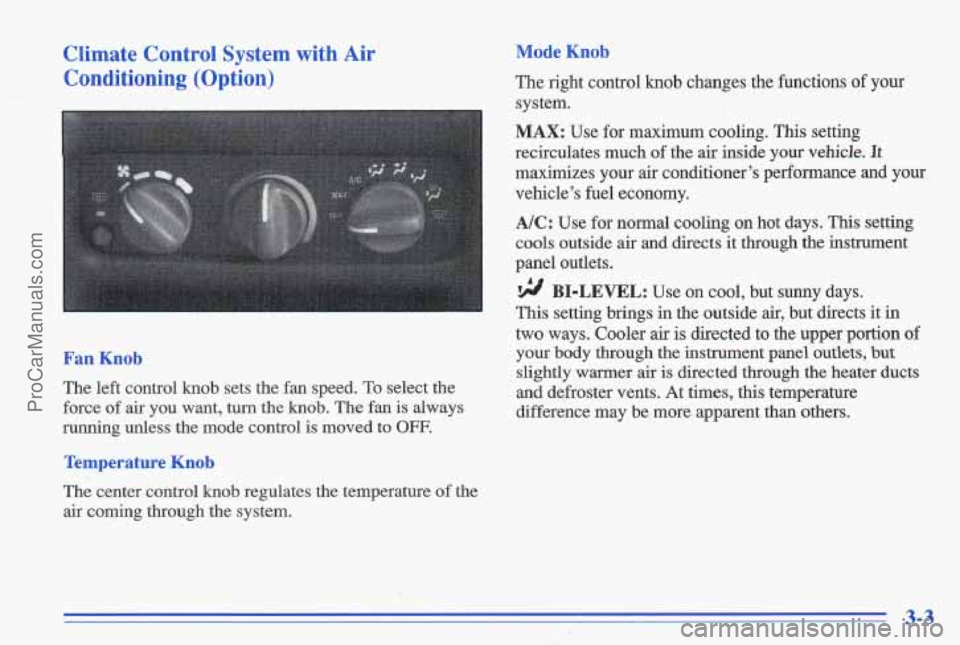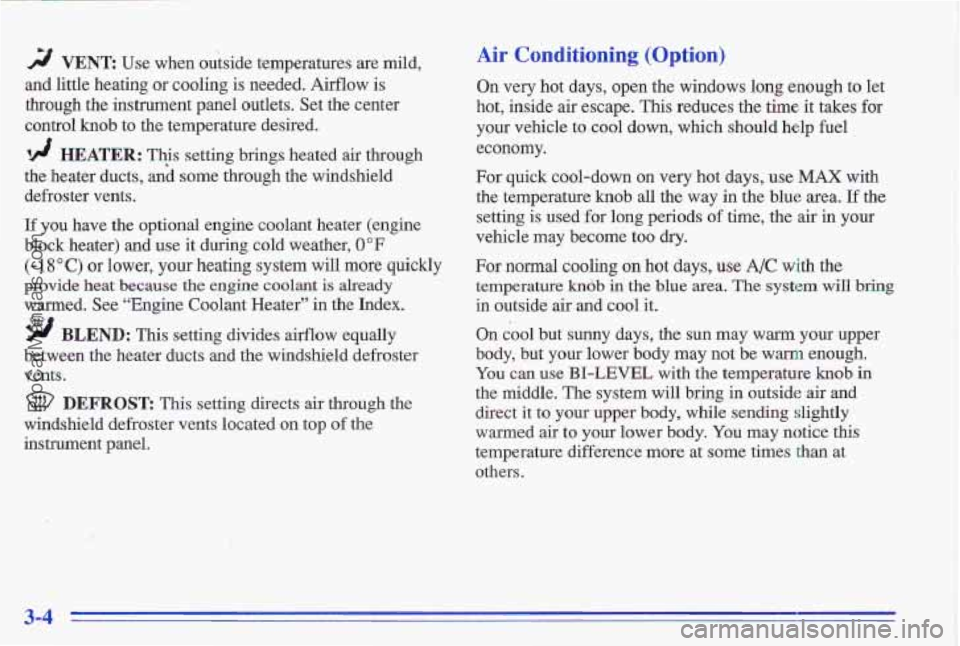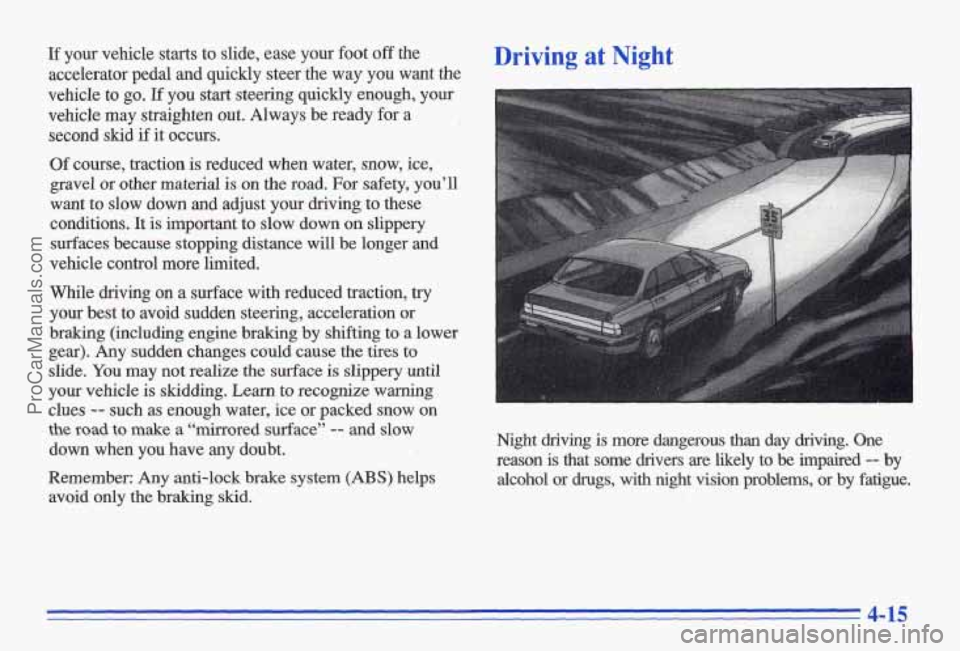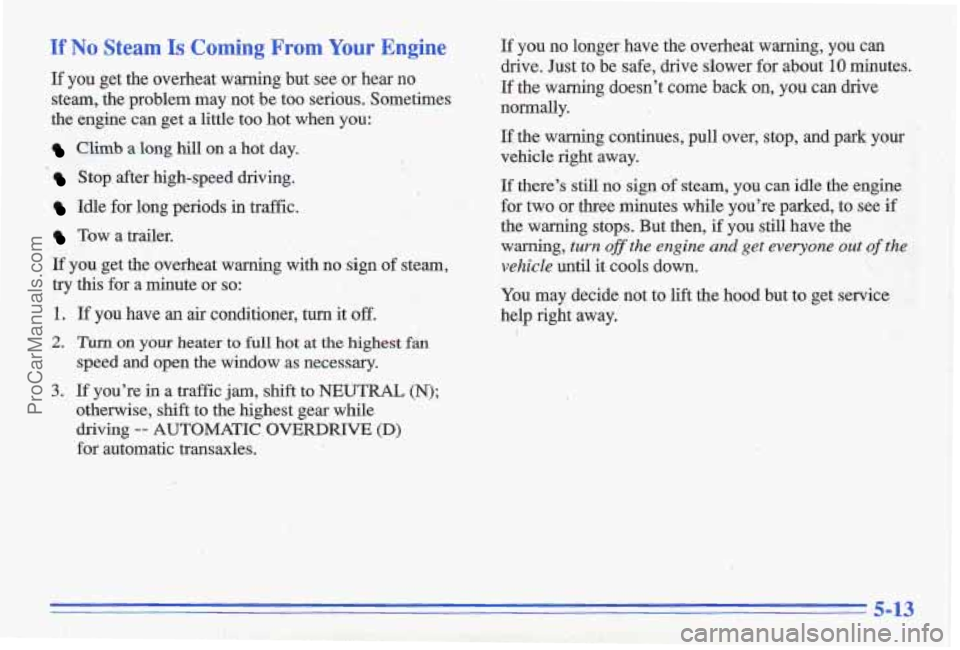1996 PONTIAC GRAND-AM air condition
[x] Cancel search: air conditionPage 112 of 356

Charging System Indicator Light
The charging system
indicator light will come on
briefly when
you turn on the
ignition, but the engine
is
not running, as a check to
show you it is working.
Then it should go out. .. 1.
. I -1
If it stays on when your engine is running, OF comes on
while you are driving, you may have a problem with the
electrical charging system. It could indicate that you
have a loose generator drive belt or another electrical
problem. Have it checked right away. Driving while this
light
is on could drain your battery.
If you mast drive a short distance with the light on, be
certain to turn off all your accessories, such as themdio
and
air conditioner,
Brake System Warning Light
Your Pontiac’s hydraulic brake system is divided into
two parts. If one part isn’t working, the other part can
still w’ork and
stop you. For good braking, though, you
need both
parts workmg well.
If the warning light comes on, there could be a brake
problem. Have your brake system inspected right away.
BRAKE
This light should come ow
briefly when you turn the
ignitibn key
to RUN. If it
doesn’t come on then, have
it fixed so it will be ready to
warn
you if there’s a
problem,
If the light .comes on while you are driving, pull off the
road and stop carefully. You may notice that the pedal is
harder to push. Or, the pedal may go closer to the floor,
It may take longer to stop. If the light is still on, have the
vehicle towed €or
service, (See “Towing Your Vehicle”
in the Index.)
2-56
ProCarManuals.com
Page 117 of 356

I NOTICE:
If you keep driving your vehicle with this light
on, after a while, your emission controls may nmot
work as well, your fuel economy may not be as
good and your engine may not run as smoothly.
This could lead to costly repairs that may not be
covered by your warranty.
This light should come on, as a check to show you it is
working, when the ignition
is on and the engine is not
running.
If the light doesn’t come on, have it repaired.
This
light will also come on during a malfunction’ in one
of two ways:
0 Light Flashing -- A misfire condition has been
detected.
A misfire increases vehicle emissions and
may damage the emission control system on your
vehicle. Dealer or qualified service center diagnosis
and service is required.
0 Light On Steady -- An emission control system
malfunction has been detected on your vehicle.
Dealer or qualified service center diagnosis and
service may be required.
If the Light Is Flashing
The following may prevent ml
your vehicle:
0 Reduce vehicle speed.
0 Avoid hard accelerations.
0 Avoid steep uphill grades.
e serious damage to
i
If towing a trailer, reduce the amount of cargo being
hauled as-soon as it is possible.
If the light stops flashing and remains on steady, see “If
the Light Is On Steady” following.
If the light continues to flash, when it is safe to do so,
stop the vehicle. Put your vehicle in PARK (P). Turn the
key off, wait at least 10 seconds and restart the engine.
If the light remains on steady, see “If the Light Is On
Steady” following.
If the light is still flashing follow the
previous, steps, and drive the vehicle to
your dealer or
qualified service center for service.
2-61
ProCarManuals.com
Page 118 of 356

If the Light Is On Steady
You may be able to correct the emission system
malfunction by considering the following:
Did you just put fuel into your vehicle?
If
so, reinstall the fuel cap, making sure to fully install
the cap. The diagnostic system can determine if the fuel
cap has been left
off or improperly installed. This will
allow fuel to evaporate into the atmosphere.
A few
driving trips should turn the light,off.
Did you just
drive through a! deep puddle of water?
If so, your electrical system may be wet. The condition
will usually be corrected when the electrical system dries out.
A few driving trips should turn the light off.
Are you low on fuel?
As your engine starts to run out of fuel, your engine may
not
run as efficiently as designed since small amounts of
air are sucked into the fuel line causing a misfire. The
system can detect this. Adding fuel should correct
this
condition. Make sure to install the fuel cap properly. It
will take a few driving trips to turn the light
off.
Have you recently changed brands of fuel?
If so, be sure to fuel your vehicle with quality fuel (see
“Fuel” in the Index). Poor
fuel quality will cause your
engine not to run as efficiently as designed. You may
notice this as stalling after start-up, stalling when you
put the vehicle into gear, misfiring, hesitation on
acceleration or stumbling
on acceleration.. (These
conditions may go away once the engine
is warmed up.)
This will be detected by the system and cause the light
to turn on.
If you experience this condition, change the fuel brand
you use.
It will require at least one full tank of the
proper fuel to turn the light
off.
If none of the above steps have made the light turn off,
have your dealer or qualified service center check the
vehicle. Your dealer has the proper test equipment and
diagnostic tools to fix
any mechanical or electrical
problems that may have developed.
ProCarManuals.com
Page 125 of 356

Climate Control System with Air Conditioning (Option)
< _.-
1 !
Mode Knob
The right control knob changes the functions of your
system.
MAX: Use for maximum cooling. This setting
recirculates much
of the air inside your vehicle. It
maximizes your air conditioner’s performance and your
vehicle’s fuel economy.
A/C: Use for normal cooling on hot days. This setting
cools outside air and directs it through the instrument
panel outlets.
BI-LEVEL: Use on cool, but sunny days.
This setting brings in the outside air, but directs it in
two ways. Cooler air
is directed to the upper portion of
Fan Knob your body through the instrument panel outlets, but
slightly warmer air is directed through the heater ducts
The left control
knob sets the fan speed. To select the and defroster vents. At times, this temperature
force of air
you want, turn the knob. The fan is always difference may be more apparent than others.
running unless the mode control is moved to
OFF.
Temperature Knob
The center control knob regulates the temperature of the
air coming through the system.
3-3
ProCarManuals.com
Page 126 of 356

rF/ VENT Use when outside temperatures are mild,
and little heating or cooling is needed. Airflow is
through the instrument panel outlets. Set the center
control
knob to the temperature desired.
‘!! HEATER: This setting brings heated air through
the heater ducts, aid some through the windshield
defroster vents.
If you have the optional engine coolant heater (engine
block heater) and use it during cold weather,
0°F
(- 1 8 O C) or lower, your heating system will more quickly
provide heat because
the engine coolant is already
warmed. See “Engine Coolant Heater”
in the Index.
9 BLEND: This setting divides aeflow equally
between the heater ducts and the windshield defroster
vents.
DEFROST This setting directs air through the
windshield defroster vents located on top of the
instrument panel.
Air Conditioning (Option)
On very hot days, open the windows long enough to let
hot, inside air escape. This reduces the time it takes for
your vehicle to cool down, which should help fuel
economy.
For quick cool-down on very hot days,
use MAX with
the temperature
knob all the way in the blue area. If the
setting is used for long periods
of time, the air in your
vehicle may become too dry.
For normal cooling on hot days, use A/C with the
temperature
kndb in the blue area. The system will bring
in outside air and cool it.
On cool but sunny days, the sun may warm your upper
body, but your lower body may not be warm enough.
You can use BI-LEVEL with the temperature knob in
the middle. The system will bring in outside air and
direct it to your upper body, while sending slightly
warmed air
to your lower body. You may notice this
temperature difference more at some times than at
others.
3-4
ProCarManuals.com
Page 127 of 356

Hc-4ing
‘lix---lg the right control knob to HEATER and the
center control
knob clockwise sends some heated air
through the heater ducts toward your feet and some
through the defroster vents.
Veri, 3ys1
Use when outside temperatures are mild, and little
heating or cooling is needed. Turn the right knob to
VENT. Airflow is directed through the instrument panel
outlets. Set the center knob to the temperature desired.
VENT and HEATER are economical positions because Your Pontiac’s flow-through ventilation system supplies
the air conditioner compressor doesn’t run in these two outs\
ide air into the vehicle when it is moving. Outside
settings. This reduces engine load, resulting in improved
air will also enter the vehicle when the heater or the air
fuel economy.
If either setting fails to keep you conditioning fan is running.
comfortable, or causes your windows to fog up, turn
the right control
knob to one of the air conditioning Adjust the direction of
positions, or to DEFROST. airflow by moving the
If
you have the optional engine coolant heater (engine
block heater) and use it during cold weather, 0 OF ,
(- 18 O C) or lower, your heating system will more
quickly provide heat because the engine coolant is
already
warmed. See “Engine Coolant Heater”
the Index. louvered vents.
3-5
ProCarManuals.com
Page 163 of 356

If your vehicle starts to slide, ease your foot off the
accelerator pedal and quickly steer the way you want the
vehicle to
go. If you start steering quickly enough, your
vehicle may straighten out. Always be ready for a
second skid
if it occurs.
Driving at Night
Of course, traction is reduced when water, snow, ice,
gravel or other material is on the road, For safety, you’ll
want
to slow down and adjust your driving to these
conditions. It is important to slow down
on slippery
surfaces because stopping distance will be longer and
vehicle control more limited.
While driving on a surface with reduced traction, try
your best to avoid sudden steering, acceleration or
braking (including engine braking by shifting to
a lower
gear). Any sudden changes could cause
the tires to
slide. You may not realize the surface is slippery until
your vehicle is skidding. Learn to recognize warning
clues
-- such as enough water, ice or packed snow on
the road to make a “mirrored surface” -- and slow
down when you have any doubt.
Remember: Any anti-lock brake system
(ABS) helps alcohol or drugs, with night vision problems, or by fatigue.
avoid only the braking skid. Night driving
is more dangerous than day driving. One
reason
is that some drivers are likely to be impaired -- by
4-15
ProCarManuals.com
Page 203 of 356

If No Steam Is Coming From Your Engine
If you get the overheat warning but see or hear no
steam, the problem may not b'e too serious. Sometimes
the engine can get a little too hot when you:
Cbb a long hill on a hot day.
' Stop after high-speed driving.
Idle for long periods in traffic.
Tow a trailer.
If you get the overheat warning with no sign of steam,
try this for a minute or so:
1. If you have an air conditioner, turn it off.
2. Turn on your heater to full hot at the highest fan
speed and open the window as necessary.
3. If you're in a traffic jam, shift to NEUTRAL (N);
otherwise, shift to the highest gear while
driving
-- AUTOMATIC OVERDRIVE (D)
for automatic transaxles. ;+, 1; , !, -.,.r., . .-I? ,*:, I,3 : 1 I' ' . . :4?,+ . .I .
If you no longer have the overheat warning, you can
drive. Just to be safe, drive slower for about 10 minutes.
If the warning doesn't come back on, you can drive
normally.
If the warning continues, pull over, stop, and park your
vehicle right away.
If there's still no sign of steam, you can idle the engine
for two or three minutes while you're parked, to see
if
the warning stops. But then, if you still have the
warning,
turn ojf the engine and get everyone out of the
vehicle
until it cools down.
You may decide not .to lift the hood but to get service
help right 'away.
5-13
ProCarManuals.com